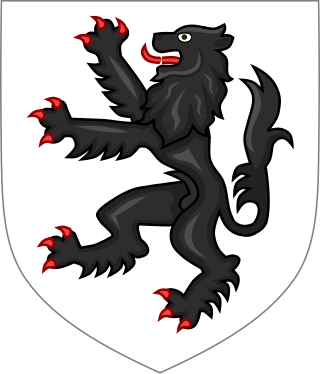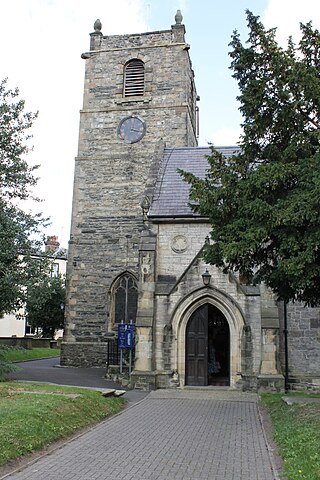Related Research Articles

Llangollen is a town and community, situated on the River Dee, in Denbighshire, Wales. Its riverside location forms the edge of the Berwyn range, and the Dee Valley section of the Clwydian Range and Dee Valley Area of Outstanding Natural Beauty, with the easternmost point of the Dee Valley Way being within the town. It had a population of 3,658 at the 2011 census.

Gruffudd ap Cynan, sometimes written as Gruffydd ap Cynan, was King of Gwynedd from 1081 until his death in 1137. In the course of a long and eventful life, he became a key figure in Welsh resistance to Norman rule, and was remembered as King of all the Welsh and Prince of all the Welsh.

William Salesbury also Salusbury was the leading Welsh scholar of the Renaissance and the principal translator of the 1567 Welsh New Testament.

Chirk is a town and community in Wrexham County Borough, Wales, 10 miles south of Wrexham, between it and Oswestry. At the 2011 census, it had a population of 4,468. Historically in the traditional county of Denbighshire, and later Clwyd, it has been part of Wrexham County Borough since a local government reorganisation in 1996. The border with the English county of Shropshire is immediately south of the town, on the other side of the River Ceiriog.
Medieval Welsh literature is the literature written in the Welsh language during the Middle Ages. This includes material starting from the 5th century AD, when Welsh was in the process of becoming distinct from Common Brittonic, and continuing to the works of the 16th century.

Madog ap Gruffudd, or Madog ap Gruffudd Maelor, was Prince of Powys Fadog from 1191 to 1236 in north-east Wales, and Lord of Powys. He was the founder of Valle Crucis Abbey, in the lordship of Yale.

Ysbyty Ifan is a small, historic village and community in the Conwy County Borough of Wales. The population in 2011 was 196 in 76 households, over 79% of the population were able to speak Welsh. It has one of the smallest populations of any Welsh community, the smallest being Ganllwyd. It is in the electoral ward of Uwch Conwy.
Simwnt Fychan was a Welsh language poet and genealogist, probably born in Llanfair Dyffryn Clwyd in north-east Wales.
Lewys Morgannwg was a Welsh language poet from Morgannwg, south Wales. He lived at St. Bride's Major
Siôn Tudur was a 16th century Welsh language poet.

William Rees, usually known in Wales by his bardic name of Gwilym Hiraethog, was a Welsh poet and author, one of the major figures of Welsh literature during the 19th century.

Llansannan is a rural village and community in Conwy County Borough, Wales. It lies on the bank of the River Aled and is about 8 miles to the south of Abergele and 9 miles (14 km) to the west of Denbigh. The population was 1,291 in 2001, with 67% able to speak Welsh. The figures for the 2011 census were: population 1,335 with 63% able to speak Welsh. The community includes the hamlets of Bylchau, Rhydgaled and Y Groes, and the lake Llyn Aled and reservoir Aled Isaf on Mynydd Hiraethog. Llansannan is in the traditional county of Denbighshire.
Hiraethog may refer to:
Gruffudd or Gruffydd is a Welsh name, originating in Old Welsh as a given name and today used as both a given and a surname. It is the origin of the Anglicised name Griffith[s], and was historically sometimes treated as interchangeable with the etymologically unrelated Germanic name Galfrid. The Welsh form evolved from the Common Brittonic Grippiud or Gripuid. The meaning of the name is “strong lord.”

Collen was a 7th-century monk who gave his name to Llangollen.
David James Bowen was a Welsh scholar and expert on the work of Welsh poets of the nobility.

St Collen's Church is a parish church in the town of Llangollen, Denbighshire, Wales. The first church on the site was founded by Collen in the 6th century. Nothing of this building remains. A new church was built in the 13th century, in the Early English Gothic style. This was developed in the succeeding centuries, and then almost completely rebuilt in the 19th century. The architect of the Victorian reconstruction was Samuel Pountney Smith, who retained little of the earlier church, with the exception of the tower. The churchyard contains the grave of the Ladies of Llangollen, Eleanor Charlotte Butler and Sarah Ponsonby, and their servant Mary Carryl, who lived at the nearby Plas Newydd. In November 2021 the first blessing of a gay partnership in a Church in Wales church was held at St Collen's. The church is an active parish church in the Diocese of St Asaph. It is designated by Cadw as a Grade I listed building.

"To the Yew Tree Above Dafydd ap Gwilym's Grave" is a 14th-century Welsh-language poem in the form of a cywydd, and is usually seen as either an elegy written after the death of Dafydd ap Gwilym or a mock-elegy addressed to him during his lifetime. Its author, Gruffudd Gryg, also wrote another elegy or mock-elegy on his friend Dafydd, and conducted a controversy in verse with him in which Dafydd's poems were criticised and defended. The cywydd on the yew tree constitutes the main evidence for the widespread belief that Dafydd is buried at Strata Florida Abbey in Ceredigion. It has been called "a superb poem, perhaps Gruffudd Gryg's best...a remarkably sensitive and perceptive act of poetic homage that acknowledges, far more than any more direct statement ever could, Dafydd's status as a true athro for his generation". It was included in both The Oxford Book of Welsh Verse and The Penguin Book of Welsh Verse.
Wiliam Llŷn was a Welsh-language poet whose work largely consists of elegies and praise-poems. He is considered the last major Welsh poet of the bardic tradition, comparable to the greatest late-medieval Welsh poets, and has been called Wales's supreme elegist. Two of his poems are included in The Oxford Book of Welsh Verse.
References
- ↑ Meic Stephens [ed.] The Oxford Companion to the Literature of Wales (Oxford University Press, 1986)
- ↑ "St Collen's Parish Church". Museums of the World. Retrieved 14 November 2021.
- ↑ D.J. Bowen (ed.), Gwaith Gruffudd Hiraethog (Cardiff, 1990). The standard edition of Gruffudd's verse.